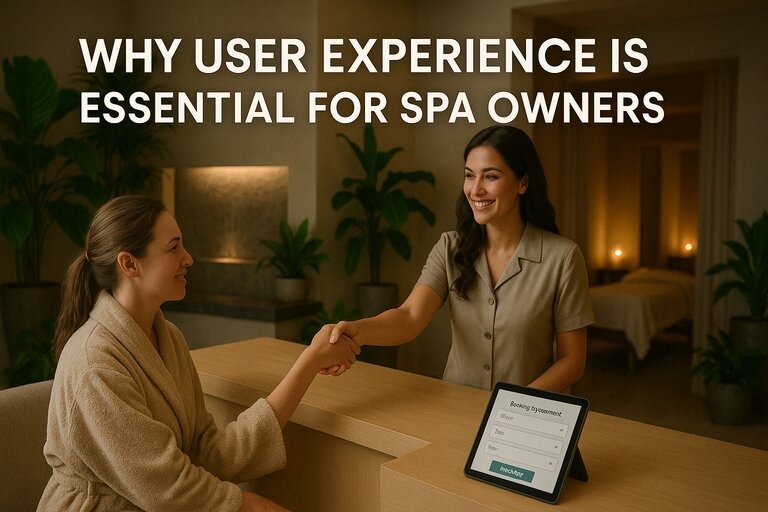
Why User Experience is Essential for Spa Owners
As a spa owner or manager, you understand how crucial a calming and enjoyable atmosphere is for your clientele. User experience (UX) in a spa context isn't just about getting customers in the door; it’s about the entire journey they take, from booking appointments to enjoying facilities.
By optimizing every touchpoint of that journey, you can drastically improve customer satisfaction and loyalty.
Identifying Pain Points: The First Step to Improvement
Have you ever thought about how your clients feel during their experience with you? Perhaps a common feedback is the difficulty in booking appointments.
Simplifying this process not only reduces frustration but also enhances overall user satisfaction. Reflect on their feedback – what are the most common complaints? Those are your hot spots for improvement!
For example, What if someone says, “I never know what to expect from my session”? that could mean your pre-service communication isn’t clear. Try sending a quick message before appointments explaining what to expect and how to prepare. It helps build trust before they even walk through the door.
Imagine a client saying, “It always feels rushed.” Even if you're on a tight schedule, clients want to feel seen and heard. A few extra minutes to chat at the beginning or end of their appointment can change their entire experience.
Or how about, “I didn’t feel like my concerns were really understood”? That’s a big one. It could be time to tweak your intake forms or ask better questions during consultations. Listening with intention can be a total game-changer.
Mapping the Customer Journey: See Your Business from Their Eyes
Have you ever tried looking at your business the way a customer would? It can be eye-opening! From the moment someone thinks, “I need a massage” to the moment they walk out your door feeling relaxed and happy, there’s a path they follow. That path is called the customer journey—and mapping it out helps you understand what it’s really like to work with you.
Start by asking:
How do they find you?
Is your website or booking page easy to use?
What happens when they arrive?
Do they feel welcomed and cared for?
How do they feel after the service—and do they want to come back?
Creating a simple visual map of these steps helps you spot where things might be confusing or frustrating.
For example, if booking online takes too many clicks or your welcome area feels awkward, that’s a chance to improve. You can even jot the journey down on paper or use tools like digital whiteboards to make it visual.
The goal is to step into their shoes and make every part of their experience smoother, clearer, and more enjoyable. When your clients feel like everything flows easily—from their first click to their final sigh of relief after a great service—they’re much more likely to return (and tell their friends, too!).
Simplifying Processes: Strip Away the Complexity
Think about the moment your clients want to book services online. If the booking system involves too many pages and questions, they may abandon their reservation altogether. Aim for simplicity. Remove redundant steps, consolidate information, and automate processes where possible to enhance accessibility.
Testing Changes and Gathering Feedback: Listening is Key
Once you have refined a touchpoint, roll out the changes to a small group first and gather feedback. Their insights are invaluable; they can help you understand if the changes result in a smoother experience or if further revisions are needed. This iterative approach ensures that any implementation resonates well with your customers.
Monitoring Ongoing Satisfaction: Never Stop Improving
After implementing changes, constantly keep an ear to the ground. Monitor customer feedback as their tastes and preferences may evolve over time. By adopting a stance of continuous improvement, you ensure that your services remain relevant and enjoyable.
The Compound Effect of Improvements: Small Changes Add Up
It’s easy to think that big results only come from big changes—but that’s not always true. In fact, some of the most powerful improvements happen when you make small, consistent upgrades over time.
Maybe you update your online booking page so it’s easier to use. Then next week, you start sending friendly reminder texts before appointments.
A few days later, you add calming music to the waiting area or offer clients a glass of water when they arrive. These may not seem like a big deal on their own—but together?
They create a smoother, more enjoyable experience that clients remember.
This is called the compound effect—where tiny improvements build on each other and lead to something much greater. When your clients notice these little touches, they start to feel truly cared for.
That builds trust, and trust leads to loyalty. Suddenly, those clients are rebooking, leaving positive reviews, and telling their friends about you.
So don’t feel overwhelmed thinking you have to fix everything at once. Focus on one small thing at a time. Over time, those thoughtful improvements will add up to a business your clients love coming back to again and again.
Final Thoughts: Walk in Your Customers’ Shoes
As a leader in your spa, it's vital to adopt the mindset of your customers. Take time to identify the friction points in their journey and proactively address them.
By genuinely considering how each process affects them, you can create loyal customers who are not just satisfied but truly delighted by their experience in your spa. The details matter immensely in this relationship!
If you’re ready to refine your spa’s customer experience and see the rewards in loyalty and satisfaction, take action now! Address one small touchpoint today and watch how it transforms your business for the better.
 Add Row
Add Row  Add
Add 







Write A Comment